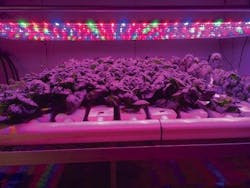DLC issues second draft of new horticultural lighting testing requirements
Interested parties can comment on the second draft of the DLC’s horticultural lighting testing and reporting requirements documents that will ultimately lead to a QPL.
The DesignLights Consortium has issued the second draft of its new “Testing and reporting requirements for LED-based horticultural lighting” document. The document specifies the parameters that solid-state lighting (SSL) manufacturers must characterize and report to ultimately have their products placed on a DLC qualified products list (QPL). Such a listing will ensure a product will be eligible for rebates or other incentives. The DLC will accept comments on the second draft until Aug 22, 2018.
Interested in articles & announcements on horticultural lighting applications and technology?
As we have reported on a recurring basis, parameters that matter in terms of lighting for people do a poor job of allowing an evaluation of how well a product might perform in a horticultural application. You can read one of our prior feature articles for a baseline understanding of evolving metrics for the horticultural application.
The new DLC testing and reporting requirements include some parameters that simply must be reported in the specification of an SSL product. And in other cases, parameters will be required to meet or exceed a performance threshold. The DLC hopes to release its finalized policy by September 2018 as part of V4.4 of the organization’s policy documents. As is the case with other lighting products, the DLC will ratchet up performance requirements in future versions, commensurate with advancements in LED and SSL technology to minimize the power loads that utilities must service.
The draft will require manufacturers to report PPF (photosynthetic photon flux) in µmol/s, PFFR (far-red photon flux) in µmol/s covering the 700–800-nm range, SQD (spectral quantum distribution) in µmol/s/nm over the 400–800-nm range, PPID (photosynthetic photon intensity distribution) in µmol/s/sr, and PFMFR (photon flux maintenance) over the 700–800-nm far-red range. Note that SQD would be represented as a graph just as is spectral power distribution (SPD) for general lighting products but with photon flux replacing the lumen.
Metrics with a required threshold start with PPE (photosynthetic photon efficacy) that must be greater than 1.8 µmol/J. And while far-red photon flux maintenance only must be reported, PPFM (photosynthetic photon flux maintenance) must meet the threshold of maintaining 90% or more of initial output for greater than 36,000 hours.
The draft further requires a specified driver lifetime of 50,000 hours or better, fan lifetime to match, a five-year warranty, greater than 0.9 power factor, and total harmonic distribution of less than 20%. Finally, a product must have a recognized safety certification.
The horticultural SSL requirements will enable growers to more easily compare products from different manufacturers and to more accurately project the return on investment that can be realized through the installation of LED lighting. We’ve had a number of articles that specifically addressed ROI relative to horticulture, but now the industry will have a more definitive set of parameters to apply in such an analysis.
The DLC has also released new drafts in policy relative to DC and Power-over-Ethernet (PoE) products, and to products with field-adjustable light output and distribution.

Maury Wright | Editor in Chief
Maury Wright is an electronics engineer turned technology journalist, who has focused specifically on the LED & Lighting industry for the past decade. Wright first wrote for LEDs Magazine as a contractor in 2010, and took over as Editor-in-Chief in 2012. He has broad experience in technology areas ranging from microprocessors to digital media to wireless networks that he gained over 30 years in the trade press. Wright has experience running global editorial operations, such as during his tenure as worldwide editorial director of EDN Magazine, and has been instrumental in launching publication websites going back to the earliest days of the Internet. Wright has won numerous industry awards, including multiple ASBPE national awards for B2B journalism excellence, and has received finalist recognition for LEDs Magazine in the FOLIO Eddie Awards. He received a BS in electrical engineering from Auburn University.






